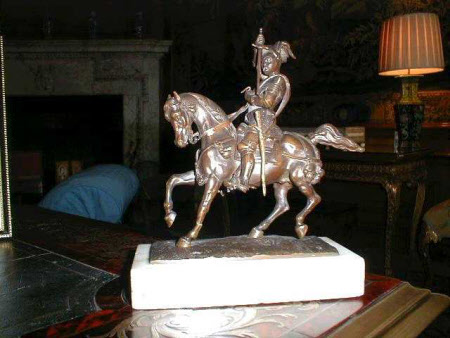Emmanuel Philibert, Duke of Savoy
after Baron Carlo Marochetti, RA (Turin 1805 – Passy, Paris 1867)
Category
Art / Sculpture
Date
circa 1835 - circa 1867
Materials
Bronze on bronze base and marble plinth
Measurements
211 x 140 x 60 mm
Order this imageCollection
Belton House, Lincolnshire
NT 435411
Summary
Bronze on bronze base and white marble plinth, Emmanuel Philibert, Duke of Savoy (1528-80), after Baron Carlo Marochetti (1805-67), after 1838. Emmanuel Philibert, Duke of Savoy, dressed in armour, riding his charger and sheathing his sword. Proper left foreleg of horse broken.
Full description
This bronze statuette is after an equestrian statue of Emmanuel Philibert, Duke of Savoy (1528-80), by Carlo Marochetti. The bronze original was produced in 1833 and first exhibited at the Louvre in 1838. It has stood ever since in the Piazza San Carlo, Turin. Marochetti made a gift of the statue to the city, his birthplace, and was thereafter awarded a baronetcy for his patriotism by King Carlo Alberto of Sardinia-Piedmont.The statue was erected during the Risorgimento, a political movement which culminated in the unification of Italy’s historic states into one Kingdom (1871). Marochetti’s choice of subject, a military leader who consolidated great territories for his duchy of Savoy, made a bold public statement. Only seventeen years earlier had a Piedmont insurgency taken place to remove the Austrians and unify Italy under the House of Savoy. The statue was considered a milestone in Marochetti’s career: locally for its tribute to Piedmont’s warrior-hero and internationally for its fashionable chivalric subject matter, in keeping with the ideals of Romanticism. Owed to this and to Marochetti’s own flair for self-promotion, miniature versions like the present example were produced on a large scale.The earliest recorded reduction is by Louis-François Jeannest, April 1838, produced when the original statue was on display in the Louvre before its move to Turin. Though this reduction was authorised by Marochetti, counterfeits, often of poor quality, soon emerged. A court case was fought to protect the sculptor’s right to reproduce or authorise reproduction of his own work, but was unsuccessful. Marochetti contracted De Braux d’Anglure and Susse Frères to produce reductions of the Turin statue, and, from 1839 he himself began to experiment with pantographic resizing machines to disseminate reductions.In 1849 Marochetti moved to London, after the fall of the July Monarchy (1848). He opened his own foundry and workshop, completing notable commissions for Queen Victoria and Prince Albert and collaborating with Landseer to make the four lions for Nelson’s Column.Marochetti worked at Belton in around 1853, when he was commissioned by Henry Cockayne Cust (1780-1861) to sculpt a funeral monument to his brother John Cust, 1st Earl Brownlow (1779-1853). This statuette may have been acquired around the same time, possibly in light of John, Viscount Alford's passion for medieval history. Son of the 1st Earl, John was one of ‘thirteen knights-in-armour’ who engaged in an infamous jousting tournament at Eglington Castle in 1839 (Tinniswood, Belton House, p.28).Alice Rylance-WatsonSeptember 2018
Provenance
Purchased with a grant from the National Heritage Memorial Fund (NHMF) from Edward John Peregrine Cust, 7th Baron Brownlow, C. St J. (b.1936) in 1984.
Credit line
Belton House, The Brownlow Collection (acquired with the help of the National Heritage Memorial Fund by the National Trust in 1994)
Makers and roles
after Baron Carlo Marochetti, RA (Turin 1805 – Passy, Paris 1867), sculptor
References
Hedengren-Dillon 2014: Caroline Hedengren-Dillon, ‘L'Emmanuel-Philibert de Marochetti, Histoire d'une Réduction’, La Tribune de l'Art (2014) Ward-Jackson 2008: Peter Ward-Jackson, Marochetti, (Pietro) Carlo Giovanni Battista, Baron Marochetti in the nobility of Sardinia, Oxford Dictionary of National Biography, Oxford 2008 Ward-Jackson 2003: Peter Ward-Jackson, ‘Marochetti, Carol [Charles], Baron’, Grove Art, Oxford Art Online (2003)
